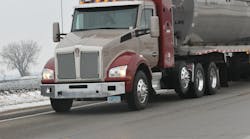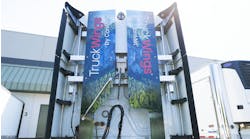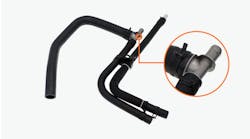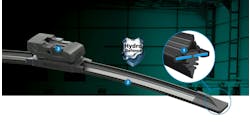Dollars and sense: The future of alternative-fuel vehicles in trucking
The increased prevalence of alternative-fuel vehicles in the trucking industry can be attributed to a number of factors, but investment is almost always driven by economics.
Fleets looking to find new and effective ways to lower overall operating costs have taken a strong interest in alternative-fuel vehicles. Those that operate in light and medium duty applications have been more inclined to buy into the technology in recent years, while heavy duty fleets have been far less likely to turn away from diesel-powered vehicles and toward alternative-fuel trucks. This is because of questions regarding the short-term and long-term monetary benefits of doing so.
“When it gets down to it, it’s always about economics,” says Tucker Perkins, chief business development officer, the Propane Education & Resource Council (PERC), an organization promotes the safe, efficient use of odorized propane gas as an energy source through investments in research, safety and consumer initiatives (www.propanecouncil.org).
COST CONSIDERATIONS
There are a number of factors for fleets to consider when deciding whether or not to buy into alternative-fuel vehicles. Among them: initial purchase price, fuel costs and maintenance costs. As a result, the majority of fleets require the promise of significant savings to encourage them to move forward with an investment.
Capital costs associated with alternative-fuel vehicles are significantly higher than with diesel-powered trucks, according to Frank Bio, director of sales development, specialty vehicles and alternative fuels for Volvo Trucks North America, a division of Volvo Truck Corporation, a leading heavy truck and engine manufacturer (www.volvotrucks.com). He estimates alternative-fuel engines and fuel systems increase the initial vehicle cost between 50 and 70 percent.
Depending on the number of miles traveled, preventative maintenance costs associated with natural gas (CNG and LNG) can be approximately $1,000 higher per year compared to current diesel engines and engine aftertreatment systems, he adds.
The initial deployment of natural gas trucks also requires additional investments from fleets.
“Fleets may need to build a fueling station or commit to minimum-purchase fueling contracts,” Bio notes. “They will need to train drivers and technicians and may need to modify their maintenance facilities.”
Additional cost considerations and added complexity have deterred some fleets – particularly those with heavy duty applications – from investing in alternative-fuel vehicles.
“When you roll all that in together, it has to show not only a savings, but generally I find a significant savings,” says Perkins. “Most of our customers are choosing payback periods of 30 months or so. That’s what they want to see.”
IS NATURAL GAS THE ANSWER?
Fleets have been compelled to invest in natural gas-powered vehicles because CNG or LNG fuel offers notable savings over diesel, says Robert Carrick, vocational sales manager, natural gas, Freightliner Trucks, a division of Daimler Trucks North America and is the leading heavy duty truck manufacturer in North America (www.freightlinertrucks.com). The difference can be in the range of around $1 to $1.50 diesel gallon equivalent (DGE).
“The future looks bright, because it’s anticipated that there will continue to be a significant enough delta between the price of diesel and natural gas to provide economic viability for natural gas vehicles,” he adds.
However, the current, low cost of diesel and diesel exhaust fluid (DEF) must be taken into consideration when looking at natural gas-powered vehicles as a viable alternative. At today’s prices, the cost for diesel and DEF for a truck running 100,000 miles a year and averaging 7.5 mpg is almost $42,000. Using natural gas at its current price and assuming approximately 15 percent degradation in fuel economy, a natural gas fuel bill would stand at about $30,000 per year. As a result, a fleet may need to wait as long as five-plus years to hit the breakeven point on a natural gas truck.
However, says Bio of Volvo Trucks, this won’t always be the case because “when diesel returns to the same price we saw just a year ago, owners will hit breakeven in about half that time,” he adds.
Freightliner’s Carrick says the best applications to realize a quick payback on an investment in a natural gas-powered vehicle are ones that require 15,000-plus gallons of fuel per truck per year. However, he notes that Freightliner has deployed natural gas trucks and tractors into almost every application, and the company has found vehicle performance and life is essentially the same as diesel-equipped trucks.
FUELING
Fleets that employ their trucks in closed-loop applications, where they return to the same location day in and day out, are also in better position to leverage alternative fuels to increase cost savings because of their ability to use centralized fueling. This is also one of the main reasons why the heavy duty trucking industry has been less inclined to invest in the technology.
Fueling station infrastructure remains a significant hurdle to widespread adoption as well. While it continues to improve with time, many fleets that have decided to purchase alternative-fuel vehicles have been forced to build their own fueling stations to accommodate their vehicles, or they choose routes that provide access to fuel stations.
In addition, Volvo Truck’s Bio says, trucks equipped with natural gas engines are less aerodynamic than comparable diesel-powered models. The back-of-cab tanks on natural gas trucks are outside the truck’s profile, causing air detachment and increasing drag.
What’s more, the chassis tanks use less-than-optimized covers.
HURDLES
A number of other factors have also held back the investment in natural gas-powered vehicles by heavy duty fleets. These include fuel range anxiety, fuel tank weight and engine performance.
However, the adoption of these vehicles has been strong in certain heavy duty markets, such as refuse and transit bus, says Bio of Volvo Trucks. These fleets are committed to replacing a significant percentage of their vehicles with natural gas-powered equipment and have driven demand for the 9L Cummins ISL-G natural gas engines.
“The next logical market is for the natural gas 12L Cummins ISX12G engine, which is used for regional and medium-haul – 500 miles or less – dedicated runs where fuel is readily available,” he says. “Some private carriers have committed to the technology and have used incentives to build infrastructure, which in some cases is available to other natural gas users as well.”
Bio says he believes the potential for additional infrastructure will spur increased adoption of natural-gas-powered vehicles in trucking, given that fleets will see a reasonable return on investment.
“Even with today’s lower diesel prices, customers that have purchased natural gas trucks previously are continuing to do so,” he notes. “But persuading others to adopt natural gas is more difficult because the payback now takes twice as long as it did a year ago. Customers need some financial reward for converting to natural gas.”
MAINTENANCE
A typical maintenance schedule for a natural gas-powered vehicle is similar, but not identical, to that of a diesel-powered one.
Based on more frequent maintenance schedules and the cost of spark plug replacement, maintenance on a CNG-powered truck is approximately about one to two cents higher than diesel-based trucks, says Freightliner’s Carrick. “However, the cost of spark plugs has decreased over the past year, and when combined with sometimes unexpected aftertreatment systems costs on diesel engines, most customers have found that maintenance costs end up being comparable.”
According to Bio, oil drain intervals are shorter – 25,000 miles versus 35,000 miles – and the oil used is slightly more expensive. Spark plug replacement is at 75,000 miles, and fuel tank inspections by certified tank inspectors also are required around the same mileage.
The vehicle’s fuel system has a high-pressure filter that needs inspection or replacement at 75,000 miles, and the truck’s engine aftertreatment system is a simple three-way catalyst that replaces the more complex diesel particulate filter (DPF) and selective catalytic reduction (SCR) systems required on diesel engines.
“The natural gas engines are based on their diesel-equivalent engines with about 80 percent parts commonality,” he says. “Given the similarity of the engines, the life expectancies are similar as well, although natural gas engines have higher heat rejection than diesel.”
THE RISE OF DUAL-FUEL ENGINES
Dual-fuel engines are another viable option for fleets, and perhaps a more attractive one for those concerned with total cost of ownership related to alternative-fuel vehicles. These engines are based on typical diesel engines, but they include dual fuel-specific hardware.
Natural gas is introduced into the engine’s intake system. Then the air-to-natural gas mixture from the intake is drawn into the cylinder, as with a spark-ignited engine, but with a leaner air-to-fuel ratio. Near the end of the compression stroke, diesel fuel is injected.
The most notable characteristic of these dual-fuel engines is they can operate either on 100-percent diesel fuel or the substitution mix of diesel fuel and natural gas. While they cannot operate on natural gas alone, the engines do provide the same power density, torque curve and transient response as a base diesel engine.
According to PERC’S Perkins, diesel substitution is not for all applications, but it is viable for those where vehicles are operating in the middle of the engine power range. Generally speaking, substitution rates tend to be around 30 percent.
“The power is exceptional, and we’re seeing great success with that model,” he adds. “You will certainly see diesel substitution continue to work into all Class 8 engines, and frankly, off-road as well. It’s a good technology.”
KEY TAKEAWAYS
Whether or not a fleet will invest in alternative-fuel vehicles is a question of economics. The initial purchase price of the vehicles, fuel expense, maintenance costs and the potential for additional training and infrastructure expenses all factor into the final decision.
Many fleets require the promise of significant long-term savings and a payback period of around two-and-a-half years to sway them toward making a purchase. At this point in time, fleets employed in light and medium duty applications are finding more and more reasons to invest, while many heavy duty fleets are less apt to do so.
So what does the future hold for heavy duty fleets? According to Perkins, PERC’S efforts provide at least some idea of what to expect in the short term. The organization is currently working with a number of engine manufacturers to develop monofuel (straight) propane engines to replace diesel models.
“We see a big movement to lessen diesel,” he says. “So I think is this a year where we will at least go into a partnership with one or more engine companies to create propane-specific engines targeted at the lower levels of Class 8, in the 7L to 9L size. I think for a variety of reasons, we will transition to the lower end of Class 8 and not across all ranges, except for diesel substitution.”




